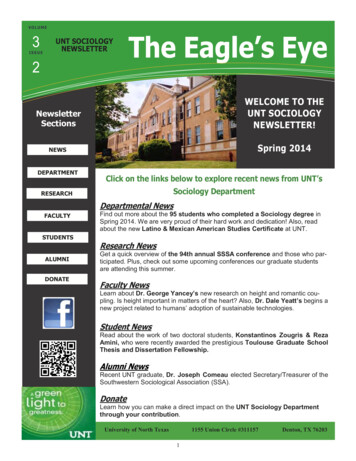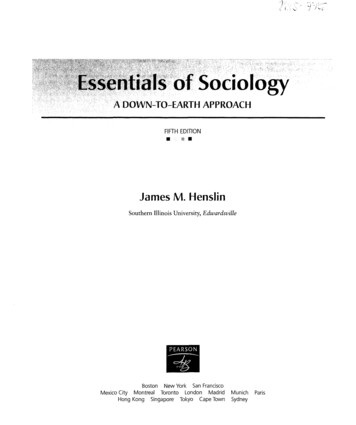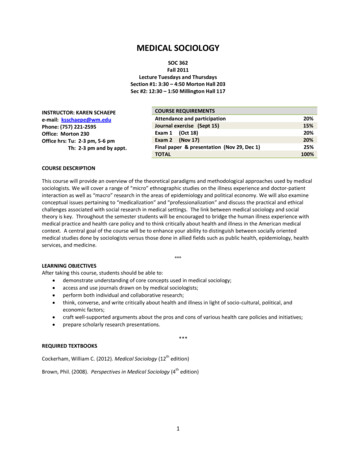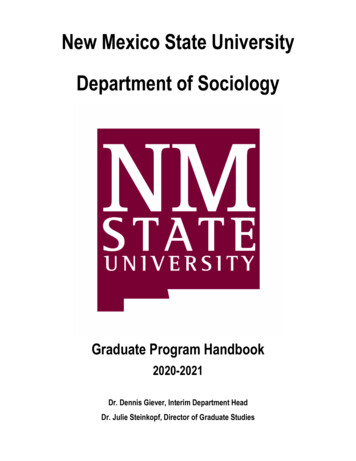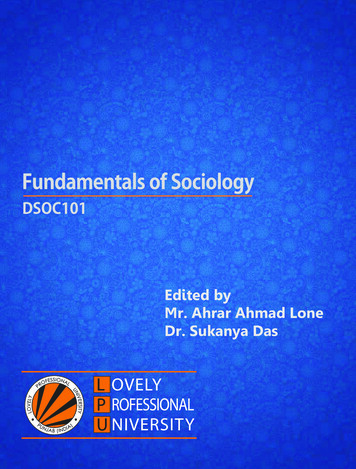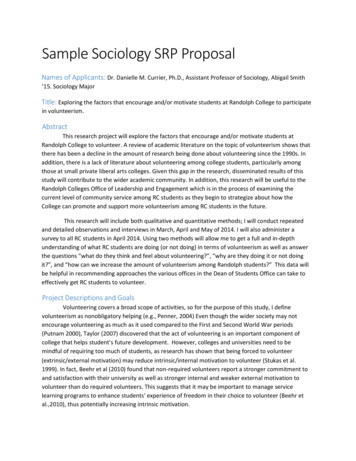
Transcription
EXAMINING THE ORIGINS OF SOCIOLOGY: CONTINUITIES AND DIVERGENCES BETWEEN IBNKHALDUN, GIAMBATTISTA VICO, AUGUST COMTE, LUDWIG GUMPLOWICZ, AND EMILEDURKHEIMMehmet Soyer, B.A.Thesis Prepared for the Degree ofMASTER OF SCIENCEUNIVERSITY OF NORTH TEXASMay 2010APPROVED:Dale Yeatts, Major ProfessorMahmoud Sadri, Committee MemberEmile Sahliyeh, Committee MemberSandra L.Terrell, Interim Chair of the Departmentof SociologyThomas L. Evenson, College of Public Affairs andCommunity ServiceMichael Monticino, Dean of the Robert B.Toulouse School of Graduate Studies
Soyer, Mehmet. Examining the Origins of Sociology: Continuities and Divergencesbetween Ibn Khaldun, Giambattista Vico, August Comte, Ludwig Gumplowicz, and EmileDurkheim. Master of Science (Sociology), May 2010, 49 pp., references, 89 titles.This thesis examines the extent to which Ibn Khaldun can legitimately be considered afounding father of sociology. To pursue this research, Khaldun’s theoretical framework will becompared with four Western scholars: Auguste Comte, Emile Durkheim, Giambattista Vico, andLudwig Gumplowicz. This paper begins with an Introduction (Chapter I), followed by a generaloverview of Khaldun’s work (Chapter II). Next, Khaldun’s work is compared to that of AugusteComte (Chapter III), Emile Durkheim (Chapter IV), Ludwig Gumplowicz (Chapter V) andGiambattista Vico (Chapter VI). In each of these chapters, Khaldun is compared and contrastedto the other social theorist, illustrating their similarities and considering their differences.Finally, in Chapter VII, I put forth conclusions that consider the extent to which Khaldun canvalidly be considered a founding father of sociology.
Copyright 2010byMehmet Soyerii
ACKNOWLEDGEMENTSI would like to offer thanks to my committee: Professor Mahmoud Sadri, Professor DaleYeatts, and Professor Emile Sahliyeh. Furthermore, I would like to express my gratitude toProfessor Rudy Ray Seward and Professor Lynne Cossman for providing me necessary andinvaluable guidance and advice.I benefited from their knowledge and experience while working on this manuscript. Ialone am responsible for any shortcomings.I would like to thank my wife, Gonca, for her support and encouragement during thisstressful time. Moreover, I would like to thank Paul A. Gilbert, Jr., and his mother, Rita Gilbert,for editing this thesis. Furthermore, my thanks go out to our families for their valuable support.iii
TABLE OF CONTENTSPagesACKNOWLEDGEMENTS . iiiLIST OF TABLES AND FIGURES. vCHAPTER I: INTRODUCTION. 1CHAPTER II: OVERVIEW OF IBN KHALDUN’S WORK . 4CHAPTER III: A COMPARISON OF THE WORKS OF IBN KHALDUN AND GIAMBATTISTA VICO . 9CHAPTER IV: A COMPARISON OF THE WORKS OF IBN KHALDUN AND AUGUSTE COMTE . 16CHAPTER V: A COMPARISON OF THE WORKS OF IBN KHALDUN AND LUDWIG GUMPLOWICZ. 23CHAPTER VI: A COMPARISON OF THE WORKS OF IBN KHALDUN AND EMILE DURKHEIM . 31CHAPTER VII: CONCLUSION . 41REFERENCES . 45iv
LIST OF TABLES AND FIGURESPageTable 1: Khaldunian Rural and Urban Society Typology . 35Figure 1: The relationship between dynastic stages and lifestyle . 8v
CHAPTER IINTRODUCTIONAkbar Ahmed, the Ibn Khaldun Chair of Islamic Studies at American University, noted:Bin Laden is a household name in the West, where, unfortunately, the names ofimportant Muslim scholars are less well known. When I talked of Ibn Khaldun,Americans usually ask: Who is he? An oil sheikh? An Arab minister? Another “terrorist”?Any links to Bin Laden? Even the scholars who have heard of Ibn Khaldun may well ask:How is he relevant to problems of the twenty-first century? (2003, p. 213)Yet, earlier generations of social thinkers contended that Khaldun was a founder ofsociology (Kremer, 1879; Flint, 1893: 158ff.; Gumplowicz, 1928: 90–114; Maunier, 1913;Oppenheimer, 1922–35, Vol. II: 173ff.; Vol. IV, 251ff.; Ortega y Gasset, 1976–8). Sorokin,Zimmerman, and Galphin believed Khaldun to be an historian, statesman, sociologist, and the“founder of sociology.” They noted that Khaldun described the transformation of Arabiansociety from badawa (rural society) to hadara (urban society), and analyzed this transition(Alatas, 2006). Harry Barnes and Howard Becker stated in their book Social Thought: From Loreto Science that “The first writer after Polybius (203–120 BC), then, to apply the equivalents ofmodern ideas in historical sociology was not a European” (1952, p. 266); they devotedsubstantial discussion to Khaldun’s ideas that are relevant to social science. By doing so, Barnesand Becker identified Khaldun as the first scholar who applied modern ideas to historicalsociology and so, from their point of view, saw him as a founder of sociology. Unfortunately,until the 19th century, Khaldunian sociology was unknown to Western scholars. From themiddle of the 19th century, Western scholars commenced studying Khaldun and his socialtheories with astonishment and admiration. Khaldun developed numerous social theoriestreated a century later by Machiavelli, and some three or four centuries later by Giambattista1
Vico, Charles de Montesquieu, Adam Smith, and Auguste Comte. After discovering andstudying Khaldun, Western scholars began considering him a philosopher, an historian ofcivilization, and a scholar of sociology and political economy (Enan, 1979).Khaldun wrote the Muqaddimah, Historical Prolegomenon (1377) in the 14th century,centuries prior to the systematic development of Western sociology. In this prominent work,Khaldun discussed scientifically the fundamental problems of what would be called modernsociology: the evolution of less-developed societies to advanced societies. Significant portionsof Khaldun’s work seem to be quite modern for his historical period (Sorokin, 1947).Historically, it has been acknowledged that Khaldun made contributions to modern sociology;however, both his concepts and methods need examination, analysis and placement in theirproper context vis-à-vis contemporary social science.This thesis examines the extent to which Khaldun can legitimately be considered afounding father of sociology. To pursue this contention, Khaldun’s theoretical framework willbe compared with four Western scholars: Auguste Comte, Emile Durkheim, Giambattista Vico,and Ludwig Gumplowicz. These prominent Western scholars were chosen for particularreasons. Auguste Comte was selected as he is often regarded as the founder of sociology.Durkheim was selected because of his position as founder of modern sociology and sociologicalmethodology. Vico was chosen because he is generally regarded as the founder of the modernphilosophy of history and Gumplowicz was selected because of his position as the founder ofconflict sociology. The paper begins with an Introduction (Chapter I), followed by a generaloverview of Khaldun’s work (Chapter II). Next, his work is compared to that of Auguste Comte(Chapter III), Emile Durkheim (Chapter IV), Ludwig Gumplowicz (Chapter V) and Giambattista2
Vico (Chapter VI). In each of these chapters, Khaldun is compared and contrasted to the othersocial theorist, illustrating their similarities and considering their differences. Finally, in ChapterVII, I put forth conclusions that consider the extent to which Khaldun can validly be considereda founding father of sociology.3
CHAPTER IIOVERVIEW OF IBN KHALDUN’S WORKIbn Khaldun (1332-1406) investigated theories of society, the basis of sovereignty orasabiyah (social solidarity), and the rise and fall of states. Born in Tunis, Tunisia, where hisparents died of the plague in 1349, Khaldun spent most of his life in North Africa and Spain. Hisfamily’s Andalusian origin suggests that his Spanish background provided Khaldun a differentperspective, and unique from the Muslim mainstream in Northwest Africa and the East (Alatas,2006).Khaldun is one of the most significant figures in the history of the Muslim world (Enan,1979). The reputation of the Muqaddimah as a significant work has brought Khaldun muchattention. Khaldun taught his theories on society, the basis of sovereignty or asabiyah, the riseand fall of states, and other subjects presented in the Muqaddimah. Khaldun described socialphenomena and situated them in the flow and perspective of historical events (Enan, 1979).Khaldun’s “New Science”Ibn Khaldun’s “new science” is interpreted as the science of human social organization,commonly interpreted as sociology. Khaldun stated that this science has “its own peculiarobject -that is, human civilization and social organization that is, explaining the conditions thatattach themselves to the essence of civilization, one after the other” (Khaldun, 1958, p. 77).From Khaldun’s perspective, civilization is the product of human interaction. Indeed,culture is not a thing in itself. The essential ability of human beings is their reflective anddeliberative competence; furthermore, human beings have the capabilities to arrange their4
relationships with other fellow human beings (Muhammad, 1998).The fundamental principles of the new science are: “ (1) the subject matter of the newscience is human association, (2) its problems are the essential modes of culture, (3) its methodis demonstration, and (4) its end is making of truth from falsehood in historical reports” (Mahdi,2006, p. 167). Khaldun maintained that he was presenting a new science that consisted of thefollowing areas: human civilization, primitive societies, the states, the cities, the crafts, theoccupations, and the sciences (Khaldun, 1958).Khaldun’s TypologyKhaldun classified societies into a dualist typology which includes badawa (rural) andhadara (urban) societies as understood by Western sociologists. Defined briefly, nomadic orrural means "inhabitant of the desert" or “the dessert dweller,” whereas urban refers to“inhabitants of cities” (Khaldun, 1958, p. 250).Rural Society (Badawa Umran)To explain the concept of badawa in his typology, Khaldun argued that primitive peopleare tied to the desert because of their agricultural life style. Since settled areas do not providewide fields and pastures for animals, their social organization is organized upon baresubsistence (Khaldun, 1958).Urban Society (Hadara Umran)The notion of urban society implies a secondary phase of social organization. People5
live clustered in cities that constitute countries. The economic arrangement of society iscentered upon commerce and crafts, in addition to agriculture and husbandry. There is a higherlevel of life observed in terms of comfort and luxury as opposed to rural society (Khaldun,1958).Khaldun’s Social ConflictKhaldun explained that social solidarity (asabiyah) plays a fundamental role in the riseand fall of societies and civilizations. Therefore, social solidarity functions “constructively” or“destructively.” Khaldun’s concept of conflict theory was based upon social solidarity(asabiyah). On the one hand, social solidarity results in consequences causing an increase insocial group adaptation. On the other hand, social solidarity (asabiyah) generates negativedynamics which destroy social groups.Khaldun’s Social Solidarity (Asabiyah)Khaldun asserted that social solidarity (asabiyah) is a vital function in explaining thecyclical theory of social change. He extended this term to indicate a universal theoreticalframework concerned with examining human social organization. Khaldun mentioned thefollowing features while describing the essentials of asabiyah: “associative sentiments, unity ofpurpose, community of social and economic interests, and oneness of feelings and emotions”(Ali, 1977, p. 118). Given these characteristics, he put forth a new essential idea that served amajor role in the transformation of society, relating a new dynamic driving force. Each societytransforms from primitive stages to advanced stages of civilization, from rural to urban. The6
way social solidarity (asabiyah) plays a major role in the rise and fall of human civilization isintrinsic in the sense that he talks about the society’s birth, growth, maturity, decadence,senility and demise (Ali, 1977).Khaldun’s Cyclical PatternKhaldun analyzed society empirically. Moreover, he explained social phenomena by anevolutionary principle of social development. He conceptualized societal development as beingparallel to the life stages of an individual: birth, maturity, and death. From this, Khaldundeveloped a spiral theory of social evolution which depicted a transformation from primitivelife to civilized urban life (Bogardus, 1960). Khaldun believed that the dynastic cycle is as “a selfdestroying but ever-rebuilt bridge between two worlds” (Arnason & Stauth, 2004, p. 36).Khaldun contended that “dynasties have a natural life span like individuals” (Khaldun,1958, p. 343). According to astrologers and physicians, the natural life span of human beings is120 years, which is the maximum time period for states as well (Azmeh, 1982). Khaldunbelieved that a dynasty lasts no longer than three generations. The life span of a generationmatches the life of an individual, which is 40 years. This time period allows one to achievematurity and growth (Khaldun, 1958). Araki (1983) summarized that Khaldun perceived that thecycle lasts three generations and took place over five stages: 1) the overthrow of opposition(stage of success), 2) the ruler’s attainment of complete control over his people (full control), 3)the stage of leisure and tranquility 4) the stage of contentment and peacefulness, and 5) thestage of waste, squandering, and disintegration (Khaldun, 1958, p. 353-5). (See Figure 1).7
Figure 1. The dynastic stages and development of civilization.8
CHAPTER IIIA COMPARISON OF THE WORKS OF IBN KHALDUN AND GIAMBATTISTA VICO (1668-1744)Giambattista Vico developed a comprehensive philosophy to address the historical andcontemporary condition of humanity by positing universalistic presumptions. He assumed thatthe history of humanity had evolved gradually, resulting in class conflict. He employed aparadigm asserting that history, a continuing process, evolves through human will in three ages:the gods age, the heroic age and the human age (Barnes and Becker, 1952). Vico hastraditionally been recognized as a social determinist; however, his historical perspective wasessentially psycho-sociological. His primary thesis was based upon a cyclical pattern of socialdevelopment. Moreover, he believed that social progress is a general and comprehensivemovement in which all dynamics have evolved concurrently. That is, Vico suggested a parallelbetween the individual and society: that we can experience a process, within ourselves, similarto that experienced by society throughout history (Barnes and Becker, 1952).Khaldun’s cyclical theory of social change overlapped Vico’s theoretical frameworkregarding the cyclical pattern. Vico developed the theory of ricorsi without knowing thatKhaldun had already formulated it in the 14th century (Gumplowicz, 1980).In 1725, Vico wrote his masterpiece The New Science (Scienza nuova). In this work, Vicodevised a cyclical theory of history (ricorsi); this theory of history is both a theory of socialchange as well as an epistemology for the study of social context. Additionally, Vico held thathuman civilization passes through the stages of the gods age, the heroic age and the human age(Baumer, 1978).9
Continuities between Khaldun and VicoVico believed that societies pass through cycles of development; moreover, societymoves through similar cycles (Lana, 1987). Khaldun 's three steps of “necessities, conveniences,and luxuries” (Khaldun, 1958, p. lxxxi) corresponded to Vico's six steps: "Men first feelnecessity, then look for utility, next attend to comfort, still later amuse themselves withpleasure, hence grow dissolute in luxury, and finally go mad and waste their substance. Thenature of peoples is first crude, then severe, then benign, then delicate, finally dissolute" (Vico,1984, p. 70).Vico argued that the development of civilizations is a spiral movement of prosperity anddecline; however, there is no one continuous or uninterrupted process indicating the pace ofdevelopment. A particular stage in a cycle is not necessarily the same as the correspondingstage in the preceding cycle and the history is not repetitive at all (Flint, 1884). Vico wrote that“Our science therefore comes to describe at the same time an ideal eternal history traversed intime by the history of every nation in its rise, development, maturity, decline, and fall” (Vico,1984, p. 104). Khaldun’s cyclical theory of social change proposed a similar contention; phasesof rise, maturation, and decline occur for all civilizations. That is, Khaldun and Vico shared thesame belief in cyclical mechanisms of change. Vico and Khaldun both embraced the notion that"The nature of peoples is first crude, then severe, then benign, then delicate, finally dissolute"(Vico, 1944, p. 70).Moreover, Khaldun and Vico agreed that factors such as religion implicate substantialchange and evolution in the civilization. Concerning religion, people tend to group together,creating a sense of solidarity. Their philosophy regarding realistic thinking was deemed a10
dichotomy of reality. Khaldun suggested that oppression and social injustice are not permanentsocietal elements. Another shared observation between Vico and Khaldun prescribed that thepowerful individual holding administrative office was revered and obeyed (Baali, 1988).The corrosion of group cohesion, as concurred upon by Vico and Khaldun, elicits thetendency to spend time on leisure or in a lifestyle of luxury. This process causes society to losesome of its values; people turn to secondary sources such as dishonesty (Lana, 1987). Vicoargued that a reverse of evolution towards minimal civilization could treat societal decay. Heunderstood this societal condition as “the returned barbarian times” (Vico, 1984, p.144). Hissolution is in line with Khaldun: Turning to the point where the state and social solidarity arefresh and powerful. Like Vico, Khaldun's premise of his framework dealt with the historicalinterpretation vis-a-vis social transformation (Baali, 1988).Finally, Khaldun and Vico shared the idea that government is natural and necessary.Furthermore, both agreed that an end to government is always found, consisting of the savageor tyrannical form. Khaldun explained social phenomenon as a cyclical theory of social change.That is, societies pass through stages of birth, growth, and death, as experienced by anindividual. Consequently, both thinkers have similar ideas concerning the rise and fall ofcivilization (Baali, 1988).Khaldun’s Contributions that are Divergent from VicoKhaldun believed that the process of the rise and decline of dynasties lasts no longerthan three generations. The first generation preserves desert characteristics, the harshness ofdesert life, and desert savagery. The strong social bond present in desert life continues to be11
preserved. Khaldun articulated that the second generation transitioned from nomadic life tocivilized life, from hardship to luxury, from a state sharing in glory to monopolization of it whileothers are too lazy to strive for it. Social solidarity is to some extent broken, and thatmonopolization of glory makes people submissive to oppression. The third generation thenforgets the period of rural life as though it had never existed. The social solidarity is brokendown and power is lost (Khaldun, 1958).Khaldun presented extensive descriptions of the process of societal progress. However,Vico developed a method which is a universal prospective on the process of societaldevelopment and change into contemporary methods (Lana, 1987). Moreover, Khaldun’scontention that society can survive and endure without religion sharply contrasted with Vico’sstatement that if religion disappears among a civilization, there is nothing left to enable thepeople to live in society (Baali, 1988). Unlike Vico, Khaldun freed himself from fables anddelusions. Khaldun did not believe "in the influence of the stars on the fortunes of individuals,nations, and states” (Baali, 1988, 126).Vico’s Contributions that are Divergent from KhaldunVico characterized historical development into three time periods. “There were threekinds of nature, three types of character, three epochs of religion, three species of language, ofwriting, of governments, of natural law, of jurisprudence, of legal judgments, etc” (Flint, 1884,p. 214). Vico maintained that the historical cycle followed these stages: (1) “anarchy andsavagery; (2) order and civilization, accompanied by the rule of reason and peaceful industry;and (3) the decay of civilization, with new barbarism setting in” (Sztompka, 1994, p. 145).12
In this conceptualization of history, Vico discussed the “natural” state of the Jews andthe Gentiles, both of which he contended were descendants of the Biblical Adam. After eventsof Noah and the flood, nevertheless, they differentiated. The Hebrews sustained their progress,never passing through the third stage of returning to barbarian times. However, after the flood,Vico believed that Gentile nations turned to the most miserable savagery. They weresubsequently saved from this state of barbarism and entered into conditions of society only bythe mechanism of a religious consciousness (Barnes and Becker, 1952).Vico held that “nations and cultures followed sequences of development which aregiven by discoverable universal principles. The beginning of this sequence can be understoodby analysis of the language of the ancient myths of a nation” (Lana, 1987, p. 158). These myths,which refer to the periods that Vico called the gods age, the heroic age and the human age,specify different modes of thought, expression, social forms, and institutions. Vico held thateach of these periods of the gods age, the heroic age and the human age were each governedby certain universal principles. As a result, the development of a word can be traced throughexamination of intellectual history in the social context of a particular society (Lana, 1987).In his work, New Science, Vico described in detail the three periods: the gods age, theheroic age and the human age.Gods AgeIn the first period, pious clergy are among the positions in government and state. Astrong religious orientation in the society is observed at the beginning of social existence. Thisforced people to think about gods and the way of communication between gods and thepeople. The pronouncements about the relation between gods and people gave birth to the13
concept of divination. The active elements of societies are the poets who were quite powerfuland influential with their words. Poets could both dramatically criticize and praise people, andthey did not refrain from unreal definitions in their poems. The gradual change evolved societyinto the next heroic age (Barnes and Becker, 1952). The application of reasoning strengthens asthe social existence matures and the society becomes less likely to understand religion as beinga fundamental pillar of the society. The community is particularly shaped by the expressionsand judgments of the group religion (Lana, 1987). During the gods age, religious principlespermeate religion, art, philosophy, regulation, political and societal organization (Sorokin,1947).Heroic AgeVico argued that a civilization starts with the second period, the ‘age of hero.’ Theheroic age begins when patriarchal rulers conquer people previously governed by priests in thegods age; this conquest causes political and social inequality, leading to a continuous strugglebetween the patriarchal governors and the governed. While the government of this period isessentially aristocratic, the democratic principle increasingly begins to express itself. Inaddition, mythological language is, in the heroic age, mostly displaced by metaphoricallanguage, and knowledge remains in the hands of the poets (Barnes and Becker, 1952). In thisphase, society is governed by an aristocratic administration where people do not receive anysupport from the government. The Gods age maintains its influence in the heroic age throughdivine concepts. This way of conducting laws develops well-defined governing principles.Therefore, “the letter of the law is supreme” (Lana, 1987, p. 158).14
Human AgeAs time passes, aristocratic government is increasingly criticized as citizens pursuegreater political freedoms in the third period, the human age. At the same time, aristocraticfamilies are increasingly weakened: through the process of marrying off their children, theirfortunes are fragmented. Accordingly, this decline of aristocratic power and the rising populardemand for political rights produces a freer society where intellectual thought and scientificaccomplishments are more possible (Lana, 1987). As the last stage, this epoch of society ischaracterized by the potential limitations of harmony and peace that can serve to reduce socialcohesion. Moreover, society experiences increasing civil equality as a universal rule, despite thecontinued existence of gaps between rich and poor even as a society becomes more egalitarian.For example, vice, dishonesty, and decadent luxuries remain prevalent among the rich despiteincreasing social equality (Flint, 1884).The human age is the last stage of civilization which results from class conflict. At thelast phase of civilization, we see the human age resulting from class conflict. In the human age,the divine providence of man is utility. In Vico’s overall conceptualization of human behavior inall three ages, first the nature of man is crude, then severe, then benign, then delicate, andfinally dissolute. With the increasing rationalism of man, human civilization evolves through thesocial arrangement types of forest dwelling, huts, villages, and cities, ending in academies. Vicostated that legislative bodies, through use of the material, economic, and intellectual assets ofthe country, create armed forces, trade, and governing classes (Vico, 1984).15
CHAPTER IVA COMPARISON OF THE WORKS OF IBN KHALDUN AND AUGUST COMTE (1798–1857)Auguste Comte, whose main theoretical frameworks consisted of the hierarchy ofsciences and the law of the three stages of social change, is often acknowledged as the founderof modern sociology. Yet, some scholars consider Khaldun as the first sociologist. Gumplowiczforcefully asserted: “I wanted to show that long before not only Auguste Comte, but also Vico,whom the Italians wanted forcibly to consider as the first European sociologist, a pious Muslimstudied with perspicacity the social phenomena, and expressed profound ideas on this subject.What he wrote is what we term today as ‘Sociology’” (Enan, 1979, p. 125). In addition, Cohen(1959) stated that Khaldun “discovered and mastered the fundamentals of sociology some fivecenturies before Auguste Comte coined the word” (p. 81). Moreover, the originality of Comte’stheories has been critiqued. Some theorists contend that “Comte made very few originalcontributions: almost all of his ideas can be traced back to numerous predecessors” (Timasheff,1955, p. 29). Arguably, Comte’s major accomplishment was to systematically synthesize andabridge several of the disparate, inarticulate doctrines of his time. Furthermore, Comte can beseen as “greatly behind the scientific achievements of his age in many ways and quite failed toabsorb many of the most important developments of the period which have since entered intosociological thought” (Becker and Barnes, 1952, p. 565).Continuities between the Perspectives of Khaldun and ComteEach scholar undoubtedly believed that his outlook was unique. Khaldun termed hisperspective ilm al-umran (science of human social organization), while Comte named his16
sociology. Furthermore, Khaldun constantly emphasized that his science of human socialorganization was novel (Baali, 1988).Another similarity between the two theorists appears in their theories of socialtransformation. Khaldun stated that societies rise and fall in three stages, and the cycle recursfrom primary stage and settlement to senility. Comte asserted that social progress is classifiedhuman knowledge which passes through three stages: the theological, the metaphysical, andthe positivistic stages. Both Khaldun and Comte discovered social phenomena according toprinciples of social development. Social development pertains to various aspects of life andcreates strong social interaction. Enhanced trade and business, cultural convergence of society,and advancements in artistic temperament are observed in communal activities throughout thisstage. Both scholars also acknowledged the essentiality of the material aspects of civilizationsuch as literature, art, and commerce. Khaldun argued that these features are the unavoidableconsequences and by-products of urbanization and urbanism (Baali, 1988).A third similarity between Khaldun and Comte is illustrated in their explanation ofhistorical-empirical method. Comte maintained that the most important aspect of humandevelopment would come through observation, experimentation and comparison accurateenough to give explanation to all experiences in terms of natural cause and effect
Auguste Comte was selected as he is often regarded as the founder of sociology. Durkheim was selected because of his position as founder of modern sociology and sociological methodology. Vico was chosen because he is generally regarded as the founder of the modern


